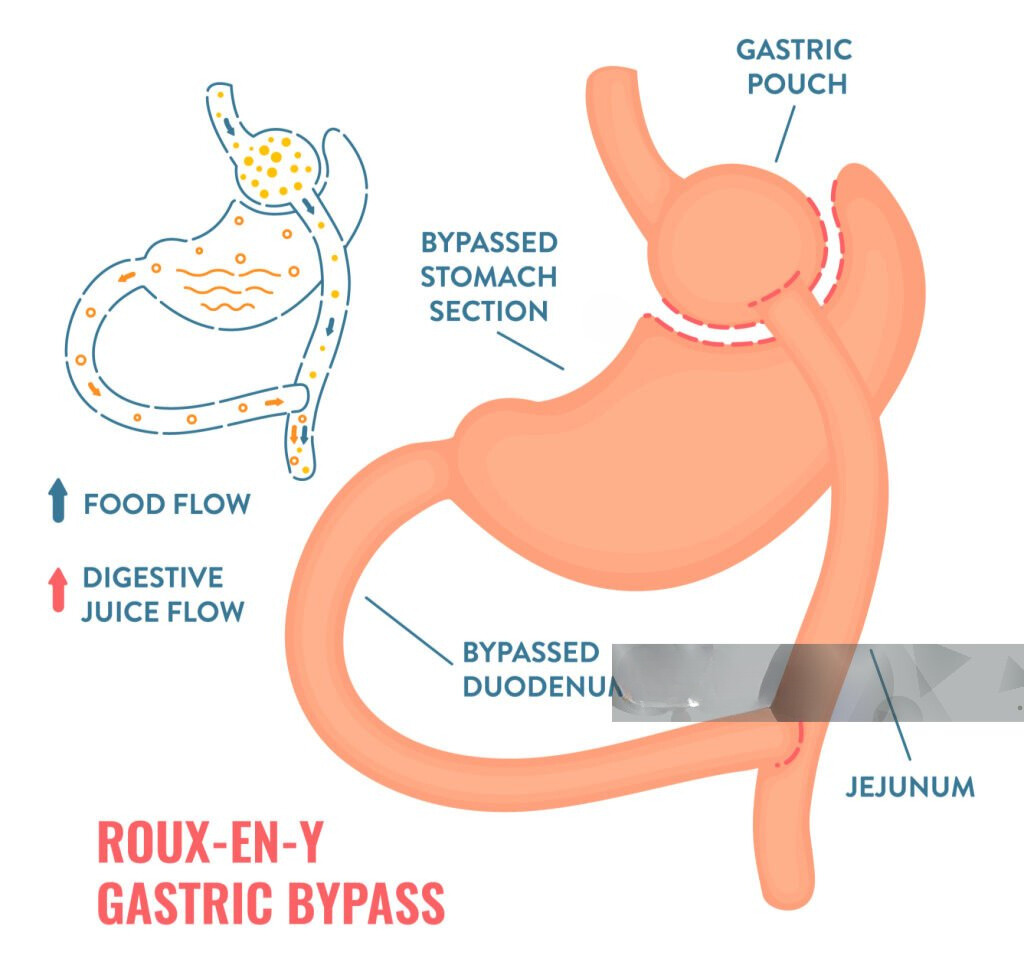
Best Clinic for Bariatric Surgery in Noida
In a sleeve gastrectomy, also known as vertical sleeve gastrectomy or the gastric sleeve procedure, the outer margin of the stomach is removed to restrict food intake. This leaves a sleeve-shaped stomach, roughly the size and shape of a banana, and retains the pylorus, the muscle that controls the emptying of food from the stomach into the intestine. Sleeve gastrectomy is a purely restrictive procedure.
By reducing the size of the stomach, a sleeve gastrectomy allows patients to feel full after eating less and consuming fewer calories. The surgery also removes the portion of the stomach that produces a hormone responsible for inducing hunger.
The sleeve gastrectomy is simpler than the gastric bypass procedure because it does not involve rerouting or reconnecting the intestines. Unlike the Lap-band procedure, the sleeve gastrectomy does not require the implantation of a banding device around a portion of the stomach.

 Mini Gastric Bypass surgery is a weight loss surgery that primarily functions as a malabsorptive procedure. In this surgery, a long, narrow gastric tube is created and directly connected to the mid-portion of the small intestine. This bypasses a significant portion of the stomach and upper intestine, reducing calorie and nutrient absorption and promoting weight loss.
Mini Gastric Bypass surgery is a weight loss surgery that primarily functions as a malabsorptive procedure. In this surgery, a long, narrow gastric tube is created and directly connected to the mid-portion of the small intestine. This bypasses a significant portion of the stomach and upper intestine, reducing calorie and nutrient absorption and promoting weight loss.
 Gastric bypass, also known as Roux-en-Y (roo-en-wy) gastric bypass, is a type of weight-loss surgery. This procedure involves creating a small pouch from the stomach and connecting this newly created pouch directly to the small intestine, bypassing a large part of the stomach and the initial segment of the small intestine. This alteration reduces the amount of food the stomach can hold and decreases nutrient absorption, aiding in significant weight loss.
Gastric bypass, also known as Roux-en-Y (roo-en-wy) gastric bypass, is a type of weight-loss surgery. This procedure involves creating a small pouch from the stomach and connecting this newly created pouch directly to the small intestine, bypassing a large part of the stomach and the initial segment of the small intestine. This alteration reduces the amount of food the stomach can hold and decreases nutrient absorption, aiding in significant weight loss.
Bariatric Surgery at Curis Multispeciality & Fertility Clinic, Noida
At Curis Multispeciality & Fertility Clinic in Noida, we understand that losing weight can be very difficult. For many people, regular diet and exercise are not enough. That’s why we offer bariatric weight loss surgery in Noida to help you achieve better health and long-term weight control.
Our clinic is known as the best clinic for bariatric surgery in Noida because of our expert doctors, advanced technology, and patient-focused care. We guide you through every step — from the first consultation to post-surgery support — to make sure you feel confident and safe throughout your journey.
What is Bariatric Surgery?
Bariatric surgery is a medical treatment for people who are very overweight or obese. It helps reduce the size of the stomach or change how your body handles food. This surgery can help you lose weight and improve health problems like diabetes, high blood pressure, and sleep apnea.
At Curis Multispeciality & Fertility Clinic, we specialize in different types of bariatric surgery to match each person’s needs. Whether you want to manage obesity or improve health conditions caused by excess weight, we are here to help.
Who Should Consider Bariatric Surgery?
You may be a good candidate for bariatric weight loss surgery in Noida if:
- Your Body Mass Index (BMI) is 35 or more with health problems.
- Your BMI is 40 or more, even without other conditions.
- You have tried diets, workouts, or medicines but did not get long-term results.
- You are ready to make lifestyle changes after the surgery.
- You are between 18 to 65 years old (exceptions may be considered).
We offer proper guidance to decide if this is the right choice for you. Our clinic takes your overall health seriously before making any decisions.
Why Choose Curis Multispeciality & Fertility Clinic?
We are proud to be known as the best clinic for bariatric surgery in Noida for several reasons:
- Experienced Surgeons: Our team includes highly trained bariatric surgeons with years of experience.
- Advanced Tools: We use modern equipment for safe and effective results.
- Full Support: From nutrition planning to post-surgery follow-up, we care for your needs at every stage.
- Personalized Plans: Each patient gets a unique plan based on their health goals and lifestyle.
We believe weight loss is not just about surgery — it’s about helping people feel better and live healthier lives.
Types of Bariatric Surgery We Offer
At Curis, we provide different types of bariatric surgery based on your health, weight, and medical history. Here are the main options:
- Gastric Bypass Surgery (Roux-en-Y)
This is one of the most common types of bariatric surgery. In this method:
- A small pouch is created from the stomach.
- This pouch is connected to a section of the small intestine.
- It limits how much food you can eat and reduces the amount of calories absorbed.
This surgery is known to help people lose weight fast and also control diabetes and heart disease.
- Sleeve Gastrectomy
In this type:
- A large part of the stomach is removed.
- The stomach becomes a tube-like shape.
- It limits food intake and also lowers the hunger hormone.
Sleeve gastrectomy is a popular option for those who want faster recovery and fewer complications.
- Adjustable Gastric Band
In this method:
- A band is placed around the upper part of the stomach.
- This creates a small pouch that holds food.
- The band can be adjusted based on weight loss progress.
Although less common now, some people still choose this for being less invasive.
- Biliopancreatic Diversion with Duodenal Switch (BPD/DS)
This is a more complex surgery that:
- Involves both stomach reduction and rerouting of the intestines.
- Leads to the most weight loss but has more risks.
Our team helps decide which of these types of bariatric surgery is most suitable for your needs.
Benefits of Bariatric Weight Loss Surgery
Choosing bariatric weight loss surgery in Noida at our clinic comes with many health benefits:
- Long-term weight loss
- Better control of diabetes, blood pressure, and cholesterol
- Relief from joint pain and back problems
- Improved sleep and breathing
- Higher energy levels
- Better mental health and confidence
Many patients say they feel like a new person after surgery. But remember, the surgery is just the first step. A healthy lifestyle and regular follow-ups are key to success.
Preparing for Surgery
Before the procedure, we guide you through the preparation process. Here’s what you can expect:
- Medical Tests: Blood tests, scans, and heart checks to make sure you’re ready.
- Diet Changes: You may need to follow a special diet 1–2 weeks before surgery.
- Counseling: Our team prepares you mentally and emotionally.
- Planning Your Stay: We explain how long you’ll stay in the hospital and what to bring.
As the best clinic for bariatric surgery in Noida, we make sure you are fully prepared before taking this important step.
After Surgery: What to Expect
Recovery after bariatric weight loss surgery in Noida is safe and smooth with the right support. Here’s what happens after:
- You may stay in the hospital for 2–3 days.
- You’ll follow a liquid diet first, then move to soft and solid foods over weeks.
- We provide a diet plan to help you get the right nutrition.
- You will have regular check-ups to track your weight and health.
- We give you access to a support group and counseling if needed.
Following the right routine after surgery helps you get the best results and avoid problems.
Our Support System
At Curis, support doesn’t stop at surgery. We are known as the best clinic for bariatric surgery in Noida because we care about your entire journey.
- Diet Support: Our nutritionists help you build good eating habits.
- Exercise Guidance: Our team helps you create a plan for staying active.
- Mental Health Care: Weight loss can bring emotional changes, and we help you handle them.
- Long-term Monitoring: Regular visits to track your progress and catch any issues early.
We stay with you through every stage of your transformation.
Real Patient Stories
Many people have trusted us for bariatric weight loss surgery in Noida. Here are a few examples:
Anjali, 38: “I lost 35 kg in one year! More than the weight, it’s the energy and happiness I’ve gained. The doctors at Curis are truly caring.”
Rohit, 42: “After trying many diets, this surgery gave me real results. The team made me feel safe and supported at every step.”
These stories show the real impact of our care and commitment.
Book a Consultation Today
If you or your loved one is thinking about bariatric weight loss surgery in Noida, we invite you to visit us. At Curis Multispeciality & Fertility Clinic, we are here to answer all your questions and guide you with honesty and care.
You can trust us as the best clinic for bariatric surgery in Noida because we put your health first — always.
To learn more or schedule an appointment, contact us through our website or call our helpline. We are ready to help you take the first step toward a healthier life.
Frequently Asked Questions (FAQs)
- Is bariatric surgery safe?
Yes, when done by skilled doctors at trusted clinics like ours, it is a safe and proven method for weight loss.
- How soon will I see results?
Most patients begin to lose weight within a few weeks, and continue seeing results for months to years.
- Will I need to take supplements after surgery?
Yes, you may need to take vitamins to avoid any deficiencies. We will guide you on this.
- Can the weight come back?
With the right diet and lifestyle, most patients maintain their weight loss. Our support team will help you stay on track.


